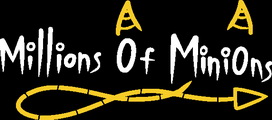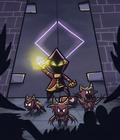Of all of the roguelites out there, few take on the Legend of Zelda-style approach where you're traversing each dungeon room by room instead of as a continuous labyrinth. The most famous one that did it was The Binding of Isaac, which has undoubtedly become one of the crown jewels of the genre at large. In trying to stand out from the crowded genre, Millions of Minions has not only taken on that same Binding of Isaac approach but also changed up a few mechanics to streamline the experience.
For a game that is simple in nature, Millions of Minions comes with a convoluted story. Long ago, there was a child born with glowing yellow eyes and a shadow that permanently covered his face. The social ridicule drove him to the woods, where he made friends with the woodland beings and nurtured his inherent powers. As the rumors of him continued to spread in town, he decided to get his revenge on the townsfolk. Hearing of this man's power, the king sent three men to find the powerful being and kill him before killing themselves with poison. The three decide to betray the king by taking away the man's power and drinking the poison anyway, leaving them to wander the dungeons as powerful shadowed zombies. Slowly, the man's power started to return, and now he's trying to escape while seeking revenge against those who tried to cripple him.
The power fantasy and infinite chains of revenge paint a tale that feels like a chore to go through due to the needless twists and details. For an introduction, it is overly long to the point that the narrator doesn't finish his side before gameplay begins. The deep-voiced narrator who speaks in such hushed tones that you need to boost your volume to understand what he's saying contrasts heavily with the cut scenes that look like they were drawn by children who only had access to a standard pencil. For many, stories in roguelites only exist as a framework for the game, but the one found here is enough to make anyone want to skip all story bits.
As alluded to earlier, the game is a roguelike that plays out like the dungeon sequences from the original Legend of Zelda. You go from room to room, destroying all of the monsters that spawn so that you can exit, and while you might run into shops that power you up, your goal is to find the one monster that holds the key to a locked room. Find that key, and you'll open up a boss room that lets you immediately take the portal they leave behind to go up one more floor to your freedom.
The main differentiator between this and most other roguelikes is your attack system. You have a basic melee attack, but it's slow, its attack range is pitifully short, and the damage it delivers is minimal at best. To make up for that, you can summon minions for both attack and defense purposes. Depending on how many minions you summon, you can surround yourself with them for protection, or you can use them as an attacking shield of sorts. You can also send minions to attack enemies, but you only fire off one minion at a time with each attack press, which makes the whole thing sort of a delayed shooter experience. One thing we haven't seen is whether you can summon different minion types. You can certainly extend the lifespan of your minions, which seems relatively short when you first bring them into the world, and you can increase their abilities, like giving them the chance to ricochet off walls, but so far, the basic idea is that the minion you start with is what you end with.
The addition of minions changes the gameplay, as you have to think about your attacks more strategically, with emphasis placed on your own positioning in relation to everyone else. That said, there is one change here to divide people, and that's the tweaks made to the roguelike mechanic. Levels are still procedurally generated, so dying means dealing with a whole new level layout, but everything else you may associate the genre with is gone. Dying brings you back to the start of the same floor you were on. When you come back, all of your upgrades for you and your minions are still intact, and so is your accumulated cash. Depending on whether or not this was intentional, it serves to be a decent way to get players into the genre without punishing them, but it also undermines some of the tenets that define the genre in the first place.
As for the presentation, it feels randomly mashed together. On the one hand, you have the graphics, which look like they were done in Flash with decent animations and bright color schemes. Though the designs of some of the monsters are supposed to be horrific, everything has a child-like quality, and even your main character looks like they wouldn't be out of place in plush form.
The cute aesthetic butts up against the music, which transforms the game into something darker with morose tones. Even then, that changes dramatically when you go into a store and the music becomes wildly cheerful. None of this is off-putting, but the contrasts will make you do a double-take. About the only thing here that is off-putting is the sound effects, which feel low impact thanks to their lower volume and lack of real punch whenever they play.
Despite its mixed-up nature, Millions of Minions is fascinating. The concept is novel, and the fact that it bucks a few roguelite traditions makes it a good choice to ease someone into the genre. Once a few more of the bugs are cleaned up, it could be a solid title for some, but we don't have to wait too long before the game is fully released to see whether that comes true.
More articles about Millions Of Minions











 Millions Of Minions is a dungeon crawler, in which you must strategically command your undead minions throughout the eerie caverns.
Millions Of Minions is a dungeon crawler, in which you must strategically command your undead minions throughout the eerie caverns.




